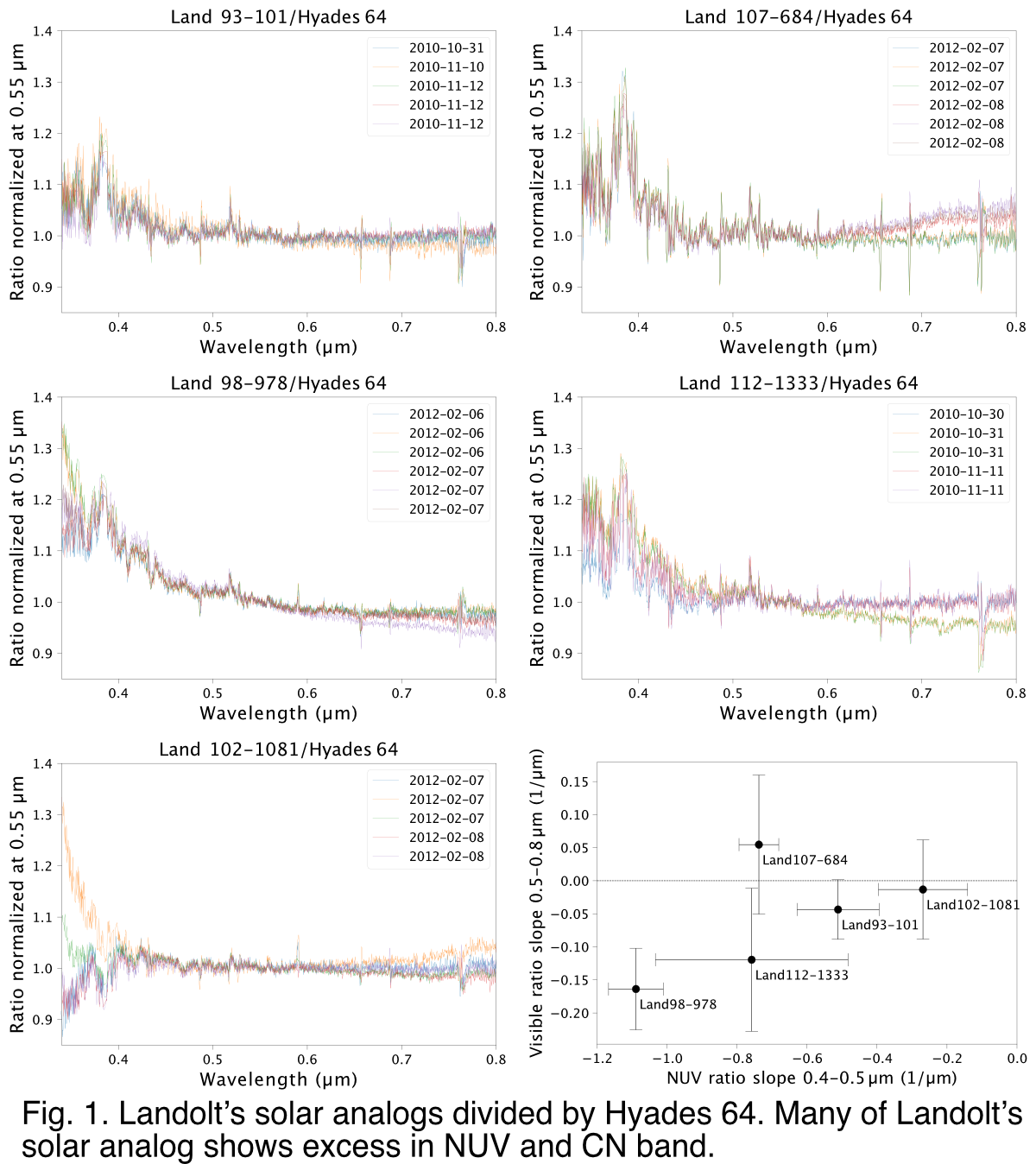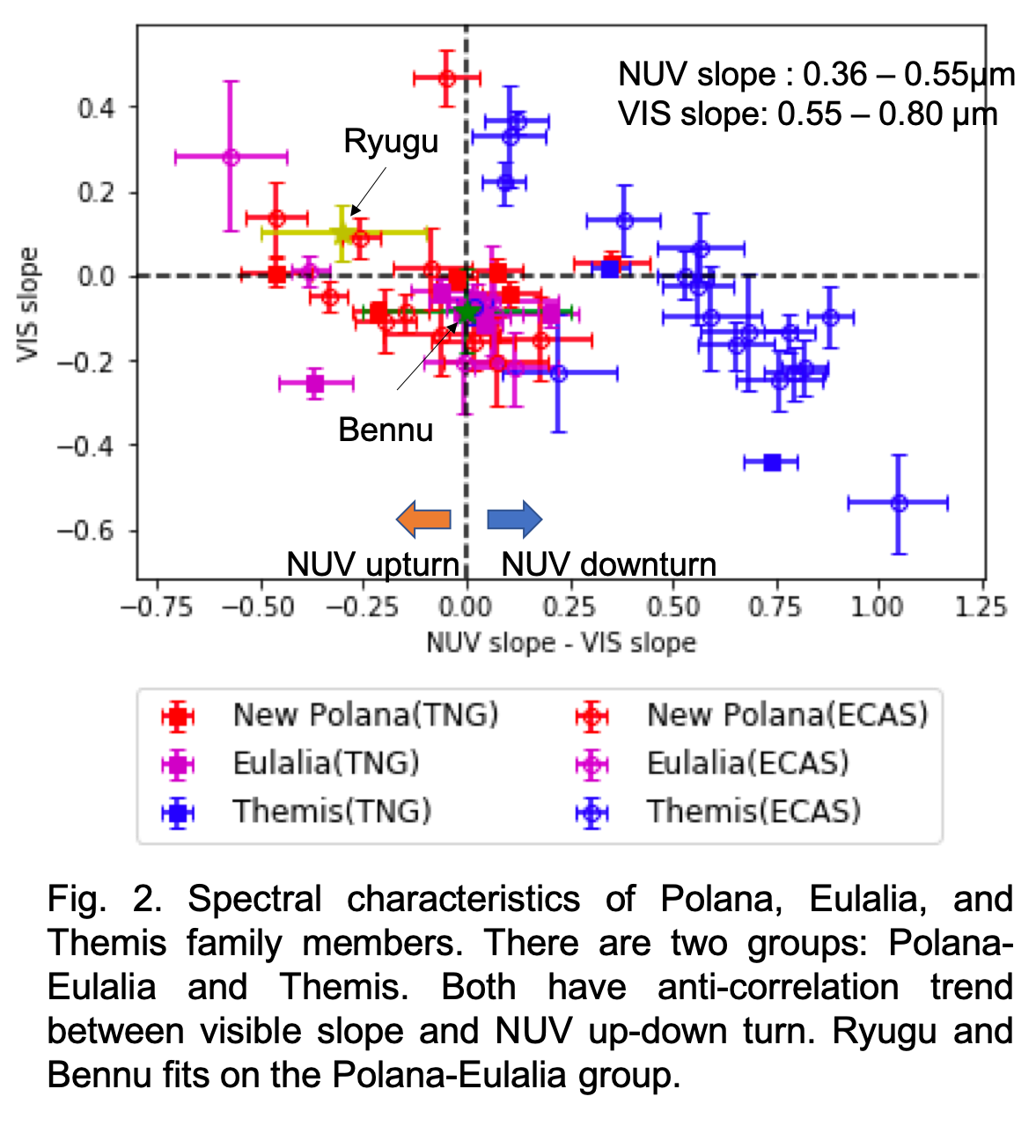- 1Instituto de Astrofisica de Canarias, Tenerife, Spain (etatsumi@iac.es)
- 2Department of Earth and Planetary Science, University of Tokyo, Tokyo, Japan
- 3Astronomical Institute of the Romanian Academy, Bucharest, Romania
Polana, Eulalia, and Themis are known to have negative spectral slope (blue) in visible wavelengths (VIS). We revisited our observations of those asteroid family members from 2010 to 2012 with the 3.56-m Telescopio Nazionale Galileo (El Roque de Los Muchachos Observatory, La Palma, Spain), in order to characterize their reflectance in the near-ultraviolet region (NUV, 0.35-0.55 µm). These spectrally blue asteroids are gaining great attention because they can be related to the sample return mission targets, (162173) Ryugu (Watanabe et al. 2019) and (101955) Bennu (Lauretta et al. 2019). These two asteroids show flat or upturn in NUV (Tatsumi et al. 2020, DellaGiustina et al. 2020). This peculiar characteristic may be a hint to seek their parent bodies. Tholen et al. (1984) suggested that spectrally blue asteroids can be categorized into two types: F and B types. Especially F types are characterized by a flat NUV reflectance. We aim to characterize the reflectance spectra of 20 members from these families and discuss the possible link to two mission targets.
In asteroid spectroscopy, to remove solar colors from the observed asteroid spectra, measurements of solar analogs (instead of the Sun itself) are commonly used. Although solar analogs are known to be spectrally similar to the Sun over the visible wavelength range, they are not very well characterized in NUV region. The stars listed in Landolt (1983) are commonly used as solar analogs. However, we found that they are not the case for NUV due to the difference in CN (~0.385 µm) absorption and metallically (Fig. 1). To avoid this problem, we use only Hyades 64 (HD 28099) to obtain the reflectance spectra. This star was well characterized in NUV by Hardorp (1978) and was found spectrally closest analog to the Sun. While the spectral differences caused by the incorrect solar analog are acceptable in visible wavelength, on the NUV region this produces erroneous results. Actually, even if we use the same data, we obtain very different NUV spectra from those presented de Leon et al. (2016), as they used Hyades 64 and several Landolt stars. This is showing how important are the solar analogs. Similarly, the Eight-Color Asteroid Survey (ECAS, Zellner et al. 1985) used only four well characterized solar analogs in the NUV to obtain their spectrophotometry from 0.32 to 1.05 µm. Thus, we collect the family member spectra also from ECAS in addition to our observations.

We measured the NUV and VIS (0.50-0.80 µm) spectral slopes for characterizing the family members (Fig. 2). The results show two groups, Themis and Eulalia-Polana. Both groups follow the trend from redder in VIS with more upturn in NUV to bluer in VIS with more downturn in NUV. The downturn in NUV typically starts at < 0.44 µm. Themis group is offset to more NUV absorption than the Eulalia-Polana group. For comparison, Ryugu and Bennu are both on the trend of the Eulalia-Polana group, which suggests two space mission targets were originated possibly from these families. Inside of each group, there is a large variation in both VIS and UV slopes, which may be caused by the hydration or by the space weathering alteration. Hiroi et al. (1996) showed that NUV absorption correlates with 3 µm absorption band based on the laboratory measurements of carbonaceous chondrites. Meaning that, more NUV downturn may indicate more hydration. Despite, a recent study (Hendrix and Vilas, 2019) showed that space weathering also affects the NUV region, suggesting that more UV upturn is proportional with the space weathering degree. If Ryugu and Bennu are originated from the same family, the degree of hydration is more plausible for explaining the NUV variation than space weathering because they show different degree of OH-band absorptions (Kitazato et al. 2019, Hamilton et al. 2019). The relation between Ryugu and Bennu will be revealed by the sample analyses in near future.
We confirmed that Eulalia-Polana members are mostly F types and Themis members are mostly B types, which is originally argued by Tholen (1984). Moreover, both Ryugu and Bennu are classified into F types in Tholen’s taxonomy. We found that there is a concentration of F types in the inner main belt region. Thus, our spectral analysis strongly suggests that both Ryugu and Bennu are originated from the inner main belt based on spectroscopy. This is consistent with probability calculation by Campins et al. (2010, 2013).

References:
- Watanabe et al. (2019) Science 364, 268.
- Lauretta et al. (2019) Nature 568, 55.
- Tatsumi et al. (2020) Astron. Astrophys. 639, A83.
- DellaGiustina et al. (2020) Science 370, eabc3660.
- Tholen (1984) PhD. Thesis, University of Arizona.
- Landolt (1983) Astron. J. 88, 439
- Hardorp (1978) Astron. Astrophys. 63, 383.
- De Leon et al. (2016) Icarus 266, 57.
- Zellner et al. (1985) Icarus 61, 355.
- Hiroi et al. (1996) MAPS 31, 321.
- Hendrix and Vilas (2019) GRL 46, 14307.
- Kitazato et al. (2019) Science 364, 272.
- Hamilton et al. (2019) Nat. Astron. 3, 332.
- Campins et al. (2010) ApJL 721, L53.
- Campins et al. (2013) ApJ 146, 26.
How to cite: Tatsumi, E., de León, J., Popescu, M., Licandro, J., and Tinaut, F.: Near Ultraviolet Observations of Polana, Eulalia, and Themis Families: Origin of Ryugu and Bennu, Europlanet Science Congress 2021, online, 13–24 Sep 2021, EPSC2021-283, https://doi.org/10.5194/epsc2021-283, 2021.

